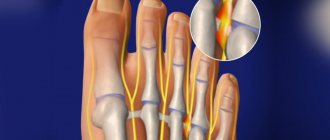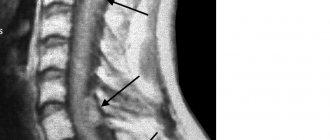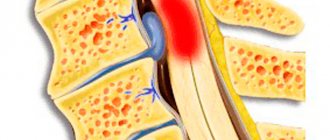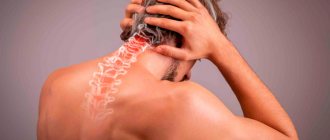12 April 2021
11179
0
3 out of 5
Neck pain is a very common problem. After all, according to medical statistics, more than 70% of people experience this periodically or regularly. Nevertheless, there are many reasons that can provoke pain of varying intensity in the neck. Most of them lie in diseases of the cervical spine. At the same time, the characteristics of pain, its localization, and the nature of other existing symptoms are important diagnostic signs that help to correctly determine what triggered them and prescribe treatment appropriate to the situation. It is very important to identify the disease causing pain in the neck as early as possible and take measures to eliminate it, since they can cause severe complications, including disability.
Causes of neck pain when turning the head
At home, you can guess the cause of neck pain when you turn your head, but a doctor will make an accurate diagnosis based on the results of the examination. During the examination, it is necessary to indicate exactly in which area the discomfort manifests itself, as well as the conditions under which it appears. The same symptoms may indicate different diseases, each of which requires its own treatment regimen.
Pathologies of the cervical spine
The cervical spine consists of 7 vertebrae and is highly mobile. The bone segments are connected to each other by ligaments, and for shock absorption there are intervertebral discs made of cartilage tissue between them. The processes of the vertebrae form channels for the passage of blood vessels and nerves. The cervical spine is the most vulnerable, since in this area the muscle layer is not strong enough for full protection. During diagnosis, acute and chronic diseases, as well as mechanical damage to the vertebrae and surrounding tissues, can be detected.
Osteochondrosis
Osteochondrosis is a chronic disease of the intervertebral discs. It often appears in old age and is associated with insufficient blood supply and nutrition of cartilage. Fabrics lose elasticity and become less durable. If normally the cartilage layer cushions when walking and when moving the head, then with osteochondrosis this function is performed insufficiently. The disease can also be a consequence of injuries, incorrect posture when walking or while working. Osteochondrosis is manifested by localized pain in the neck, dizziness, and lack of mobility of the affected area. It has a chronic course and develops in several stages:
- decreased elasticity of intervertebral cartilage and its shock-absorbing function;
- reduction of the clearance between adjacent vertebrae, which leads to compression of important nerves and arteries;
- the formation of osteophytes - bone growths that form on the articular surfaces of the vertebrae as a compensatory mechanism to prevent their abrasion during movement;
- pathological immobility of the vertebrae, increasing pain not only during movement, but also at rest, as well as mechanical damage to the nerves and vascular walls.
Acute pain in the neck when turning the head occurs with osteochondrosis of stages 2 and 3. At these stages, irreversible changes begin, the growth of the articular surfaces of the vertebrae. Osteophytes put pressure on the vertebral artery and spinal nerve roots. This leads to sharp pain in a certain position of the head, and then the pain persists even at rest. Treatment is selected individually; in the initial stages, the development of the disease can be stopped without surgery. For this purpose, special exercises, drugs to restore blood circulation and anti-inflammatory drugs are prescribed. If necessary, surgery is prescribed to remove osteophytes.
Protrusions and hernias
A common cause of sharp pain in the neck when turning the head is protrusion and hernia . They represent a protrusion of the intervertebral disc, often in the lateral directions. The pathology may be associated with incorrect posture, curvature of the cervical spine, as well as weakness of muscles and tendons. Protrusions can develop as a result of injuries, including fractures and bruises.
The intervertebral disc is a formation that consists of a strong but elastic outer fibrous membrane and a nucleus pulposus. If the vertebrae place uneven pressure on the cartilage, it begins to protrude in the direction of less resistance. Symptoms are directly related to the stage of protrusion.
- The first stage is associated with the formation of microscopic tears in the fibrous capsule. MRI shows slight protrusions in the lateral direction.
- Second degree – prolapse. Under pressure from the vertebrae, protrusions of intervertebral cartilage are formed, the dimensions of which do not exceed 3 mm.
- At the third stage, protrusions and larger hernias form . They cause acute pain when turning the head, which spreads to the neck, arm, back and shoulder blades.
- The fourth stage is rupture of the fibrous capsule. This is a dangerous condition that requires surgical treatment.
In the first stages, protrusions can be treated conservatively. The doctor prescribes painkillers and drugs to improve the nutrition of cartilage. It is also necessary to perform a daily set of exercises aimed at strengthening the muscles and ligaments of the cervical spine. They allow not only to stop the process, but also to reduce the size of the protrusion. In the third and fourth stages, most patients undergo surgery, during which the adjacent vertebrae are connected and become immobile.
Curvature of the cervical spine
Pain in the neck when tilting the head or turning it to the side often accompanies curvature of the spinal column. In the cervical region, scoliosis (lateral curvature) or lordosis is found - deviation of the axis in the anterior direction. Kyphosis is a backward bend of the spine; it is very rarely diagnosed in the neck area, since this area normally has physiological lordosis. The disease is often detected in childhood or adolescence, during periods of intensive growth. However, in adults its appearance may be associated with injuries, vitamin deficiencies, and weakness of the muscles of the cervical spine.
With the first degree of spinal curvature, a deviation from the normal position is formed by an angle of up to 10 degrees, the second - from 10 to 25, the third - up to 50 and the fourth - more than 50 degrees. Its clinical manifestations depend on the stage of the disease. Mild forms can be corrected with special exercises, correct posture and massage. For third and fourth degree curvature, surgical treatment may be required.
Spondylosis
Spondylosis is an acute or chronic condition in which pathological immobility of adjacent vertebrae is observed. Its causes are injuries, degenerative processes, osteochondrosis and other diseases of the cervical spine. Spondylosis can also be caused by injury. It develops in several stages:
- decreased elasticity of intervertebral discs;
- deposition of calcium salts in soft tissues, including in the fibers of the anterior longitudinal ligament;
- formation of osteophytes;
- in severe forms - fusion of adjacent vertebrae.
With spondylosis, pain occurs at a certain position of the head. They are associated with a mechanical effect on the roots of the spinal nerves, which are located in the damaged area. Surgical treatment consists of removing acute osteophytes or replacing the joint with an implant.
Muscle pain
One of the causes of neck pain when tilting the head forward, backward or to the side is diseases of the muscles of the cervical spine. One of them is myogelosis. Small dense nodules form in the thickness of the muscle tissue, painful when touched. They are small, the largest reaching up to several centimeters in diameter. The disease often occurs in an acute form. Seals prevent normal blood flow through the vessels and the passage of nerve impulses. They cause the following symptoms:
- acute pain in the neck, which intensifies with movement, spreads to the back of the head and shoulders;
- noticeable limitation of mobility of the cervical spine;
- headaches and dizziness;
- nausea and weakness, general deterioration of health.
Common causes of myogelosis are injuries and muscle strains, frequent hypothermia, incorrect posture while walking or working at a monitor. Nodules are easily detected by palpation; the skin over the damaged areas may become red and hot. With timely treatment, the seals disappear, and the mobility of the neck and head is restored.
Cervical migraine
Migraine is a primary headache that occurs in attacks and is chronic. One of its causes is compression of the vertebral artery, which runs in the cervical spine. This can be caused by displacement of the vertebrae, protrusion or hernia, as well as the proliferation of bone tissue and the appearance of osteophytes. Symptoms worsen after a long stay in an uncomfortable position, which puts pressure on the vascular walls. At this time, brain cells receive insufficient amounts of oxygen and nutrients and experience ischemia. Patients present with characteristic symptoms:
- neck pain caused by an underlying disease, which worsens in a certain position;
- soreness of the occipital surface of the head;
- dizziness, nausea, possible fainting due to sudden compression of the artery;
- temporary deterioration of hearing, vision, coordination of movements.
In diseases of the cervical spine, symptoms of classic migraine appear. During diagnosis, it is possible to establish its cause and prescribe treatment that will reduce the manifestations of the underlying disease. Migraine attacks can be controlled by performing special exercises to strengthen the neck muscles, dosing physical activity and monitoring your posture throughout the day.
Other reasons
Neck pain is a common symptom for a large number of diseases. Despite the similar picture, they require an individually selected treatment regimen. During diagnosis, acute and chronic diseases can be detected, including:
- rheumatoid arthritis - an autoimmune inflammation that affects the joints of the cervical spine;
- neoplasms – neurofibromas (benign neoplasms that originate from the nerve sheaths) are more often formed in this area;
- injuries - X-rays reveal dislocations and subluxations of the vertebrae, compression fractures, bruises and muscle strains are also common;
- diseases of the thyroid gland located on the front surface of the neck;
- cold viral diseases.
Neck pain often occurs in healthy people. They develop after a long stay in an uncomfortable position, improper exercise, or sleeping on a surface that is too hard or soft.
Diagnostic methods
If you experience neck pain, you should consult a therapist. After the examination, he will refer you for consultation to a doctor of a more narrow specialization. Thus, diseases of the cervical spine are treated by a vertebrologist, diseases of the nerves by a neurologist, damage to bones and soft tissues by a traumatologist. To determine the cause of pain and make an accurate diagnosis, additional examination methods will be required:
- radiography - the pictures will show fractures and dislocations of the vertebrae, signs of osteochondrosis, spondylosis, pathological growth of bone tissue;
- MRI – prescribed for suspected protrusions and hernias, as well as diseases of muscles, ligaments and tendons;
- blood tests to determine symptoms of infectious diseases and inflammatory processes;
- additional tests that will allow you to diagnose rheumatoid arthritis - determination of C-reactive protein, rheumatoid factor.
The Clinical Brain Institute has precise, modern equipment, thanks to which you can quickly obtain the necessary data. Correct diagnosis is the key to successful treatment. Complete information about the condition of the cervical spine will indicate which techniques and medications should be used for each patient.
First aid
It is impossible to undergo complex treatment at home. However, there are several ways to reduce pain before consulting a doctor:
- over-the-counter painkillers - Analgin is available in any pharmacy and in your home medicine cabinet;
- massage of the neck and head area - effective for muscle spasms, it can be performed independently;
- warm bath – relaxes muscles, improves blood circulation and relieves spasms.
If the tissues around the painful area are swollen, redness of the skin and an increase in its local temperature are observed - massage and thermal procedures are contraindicated. In this case, it is enough to take a painkiller and make an appointment with a doctor.
Diagnostics will “lead to clean water”
If your neck hurts, the pain radiates to your head, and the question of how to treat the disease correctly becomes a priority; first, you should make an appointment with a doctor and undergo an examination. Unique techniques and innovative equipment in “Hello!” clinics allow you to quickly and accurately make the correct diagnosis, and most importantly, correctly prescribe the necessary course of effective therapy.
So, first you need to establish the correct diagnosis. The main method is definitely a clinical examination by a therapist. In addition to collecting anamnesis and finding out the patient’s lifestyle, the doctor measures blood pressure and determines the body mass index. Then blood and urine tests are prescribed, which will help determine inflammatory processes and metabolic disorders.
A number of additional diagnostic examination measures may include:
- radiography - examines the bone structures of the spine;
- rheoencephalography - allows you to study the condition of the vessels of the head;
- Ultrasound examination of blood vessels - the characteristics of blood flow are assessed.
After carefully studying the data obtained, the doctor makes a diagnosis. Only eliminating the root cause of pain guarantees a lasting effect. The therapist can give a referral to other specialists, a neurologist, surgeon, ENT specialist, or dentist.
In the network of healthy spine clinics “Hello!” We employ certified doctors with many years of experience. Among them are doctors and candidates of medical sciences, professors and doctors of the highest qualification category, teachers of the department of osteopathy and manual therapy of the Russian Peoples' Friendship University. All of them have extensive experience as inpatients in leading medical and preventive institutions in Moscow and form the strongest team of experts in the field of diagnosis and treatment of diseases of the musculoskeletal system. Complex treatment in the network’s clinics is provided by doctors in such specialized areas as traumatology and orthopedics, manual therapy and osteopathy, neurology and therapy, physiotherapy and reflexology, as well as specialists in other medical professions in demand among the population.
Treatment methods
Treatment for neck pain when turning the head is selected individually. In most cases, a course of medications is sufficient to eliminate the main cause of discomfort and unpleasant symptoms. Treatment takes place at home, but the patient must periodically visit the doctor for repeated examinations and correction of the regimen. Surgery may be required in advanced cases when conservative methods are not effective enough.
- A course of medications is the basis for treating neck pain. The doctor will prescribe anti-inflammatory drugs in the form of tablets, ointments or injections. Painkillers and medications to improve blood circulation may also be required. For osteochondrosis, drugs based on chondroitin and glucosamine are effective for restoring cartilage. Muscle relaxants will relieve muscle tone and reduce compression of nerves and blood vessels.
- Surgeries are prescribed if drug treatment does not help. Minimally invasive removal of hernias, neoplasms, and osteophytes in advanced stages of osteochondrosis is practiced. Joint surgery is performed under the control of an arthroscope - a special device that allows you to visualize the picture through small punctures, without large incisions.
- Additional techniques are required for complex treatment. At home, you need to perform simple exercises to strengthen the muscles of the cervical spine. The doctor may also prescribe wearing an orthopedic collar, physiotherapy sessions and therapeutic massage.
Doctors at the Clinical Brain Institute specialize in treating diseases that manifest as neck pain. The effectiveness of the techniques depends, among other things, on the correct implementation of the recommendations. It is important to take prescribed medications on schedule, do exercises, and contact for follow-up consultations on time.
General information and classification
Medical terminology has provided a special name for pain in the cervical spine - cervicalgia. However, this definition can only be applied if the pain does not “give” anywhere - neither to the arms, nor to the head, etc. At the same time, there are several other concepts for cervical pain with innervation:
- if it innervates the arm, the pain is called “cervicobrachialgia”;
- if the pain radiates to the head, it is called “cervicocranialgia”;
- if there is a “shooting” in the neck, the condition is called “cervicago.”
A condition in which the neck hurts when turning or tilting the head can be either a manifestation of problems with the spinal column itself, or evidence of the development of serious ailments. The fact is that the neck contains a large number of organs - the esophagus, trachea, thyroid gland, lymph nodes and larynx.
Preventing neck pain
Most diseases that cause neck pain when turning the head are chronic. Their development can be stopped if you regularly follow simple prevention rules. Doctors recommend the following measures:
- correct posture in everyday life, as well as while working at the monitor;
- a suitable mattress and pillow - blood circulation should not be impaired during sleep;
- proper nutrition with sufficient vitamins and microelements;
- diet if necessary - excess weight often causes chronic diseases of the spine;
- moderate physical activity.
The Clinical Brain Institute offers individual programs for diagnosing and treating neck pain. Here you can get advice from narrow and general doctors, specialists with many years of experience. Modern equipment is used for the examination, which allows you to obtain accurate data. Treatment takes place on an outpatient basis or in a hospital.
Clinical Brain Institute Rating: 4/5 — 13 votes
Share article on social networks
How to get rid of pain
If pain in the left neck occurs due to diseases of the spine or muscles, treatment will be the same as for similar problems in other areas of the back: anti-inflammatory tablets and ointments, physiotherapy, massage, and then, in some cases, physical therapy.
What should you do if your neck on the left side hurts badly, and you don’t see a doctor until tomorrow morning? You can use anti-inflammatory gels or ointments. Products containing diclofenac will not harm if the skin over the sore spot is not damaged. Warming ointments are possible for pain due to physical activity or, conversely, an uncomfortable static position, but it is strictly forbidden if there is a risk of injury.
If pain in the neck is not associated with the spine, or is caused, for example, by a tumor, abscess, inflammation of the nerve plexus, such treatment will not help, you need to look for and eliminate the cause. But in this case it is useless to guess: medical assistance is needed.









